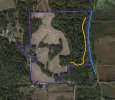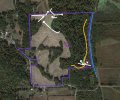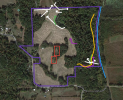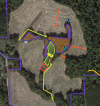Chuck11
5 year old buck +
Okay, so I'm going to start over with my thought process here. Brand new to land management, not brand new to planting and general growing and sowing practices. This property is located in western Kentucky. It is very lightly hunted one weekend in October and again from the 13-28th of November. I have a pretty diverse background in horticulture and gardening and quite a bit in the landscaping skillset too. I'm no stranger to hard work. I am a stranger to understanding deer and how to really set up the land for optimal use. I will preface that this land is a lease that we have a LOT of freedom to do what we want with. The only caveat is we cannot mess with the Ag land at all. A farmer has that lease and they grow corn or soybeans during the summer, and winter wheat during the fall/winter.
Second big factor, this property is overrun with does. In the south field, a month ago we counted 54 deer on the lower field eating at the underbrush. I did take a 12 point 3.5 year old buck in the North field in mid-December last year that was apparently determined to late rut off a cold front. The following pictures will show what I am working with. We want to begin some land management in the winter after hunting and into the spring and summer next year to begin improving the hunting property to better understand and hunt the deer movement. I live 8 hours from this property, but my dad lives about 20 minutes from it. I don't mind making the drive to do projects, but I have to have a pretty clear plan and purpose to the trips I do take.
The first picture shows what's here. The yellow trail is an existing 4 wheel trail that cuts through the bottoms. The blue is a creek bed that has water in it about half the year. The creek bed sits about 4-6 feet below grade at the bottoms.

The next picture shows observed deer travel that we have seen either from stands during the hunting seasons mentioned or on trail cameras. I have about 7 trail cameras at my disposal that I can move about the property, Three old school ones that are just SD card capable and not cellular. I have one cellular that is capable of just uploading still pictures. I have two cell cameras that are capable of uploading pictures and video. I didn't want to get more in the woods this year because time ran short and we were already cutting it close getting stands in the woods and getting back out a month before the season began. The purple arrows are morning movement, green is midday movement and white is night movement. Other than the Ag field, and a some acorns, there is no food source that is readily available on the property.

This is a 55 acre plot, and even though we have stands out and have had success hunting this, we would like to set this up to maximize it's potential. Even doing small things from year to year is fine. But you listen to guys like Jeff Sturgis and he says first and foremost food, and then other guys say bedding and travel corridors and others say hinge cuts and funnels and stand access. So my question is, where do you start? I don't want to make big changes right off the get, and you can't un-chainsaw a tree. You can always not replant food and move food plots, and I'm okay with mild expense. I'm not rich, but I've got a decent amount of expendable income. I'm just at a loss for where to begin, and open to discussion and suggestions on where you would start.
Bill has already made some good suggestions, and I appreciate the input and feedback. Feel free to copy the images and use whatever you can to draw on the map to illustrate exactly what you're talking about. I'd like to get a plan explored and try some things out so I can observe how they work on the land over the next season. No idea or question is too stupid in my opinion. Even things that you've done and failed and or done and had success with on your own land is good information. And if I ask what seems to be a stupid question, I'm not being ignorant. I'm just trying to understand why and how things are done. But I feel like I need to take about a dozen steps back from where my brain is and focus on small things and take things one step at a time.
Second big factor, this property is overrun with does. In the south field, a month ago we counted 54 deer on the lower field eating at the underbrush. I did take a 12 point 3.5 year old buck in the North field in mid-December last year that was apparently determined to late rut off a cold front. The following pictures will show what I am working with. We want to begin some land management in the winter after hunting and into the spring and summer next year to begin improving the hunting property to better understand and hunt the deer movement. I live 8 hours from this property, but my dad lives about 20 minutes from it. I don't mind making the drive to do projects, but I have to have a pretty clear plan and purpose to the trips I do take.
The first picture shows what's here. The yellow trail is an existing 4 wheel trail that cuts through the bottoms. The blue is a creek bed that has water in it about half the year. The creek bed sits about 4-6 feet below grade at the bottoms.

The next picture shows observed deer travel that we have seen either from stands during the hunting seasons mentioned or on trail cameras. I have about 7 trail cameras at my disposal that I can move about the property, Three old school ones that are just SD card capable and not cellular. I have one cellular that is capable of just uploading still pictures. I have two cell cameras that are capable of uploading pictures and video. I didn't want to get more in the woods this year because time ran short and we were already cutting it close getting stands in the woods and getting back out a month before the season began. The purple arrows are morning movement, green is midday movement and white is night movement. Other than the Ag field, and a some acorns, there is no food source that is readily available on the property.

This is a 55 acre plot, and even though we have stands out and have had success hunting this, we would like to set this up to maximize it's potential. Even doing small things from year to year is fine. But you listen to guys like Jeff Sturgis and he says first and foremost food, and then other guys say bedding and travel corridors and others say hinge cuts and funnels and stand access. So my question is, where do you start? I don't want to make big changes right off the get, and you can't un-chainsaw a tree. You can always not replant food and move food plots, and I'm okay with mild expense. I'm not rich, but I've got a decent amount of expendable income. I'm just at a loss for where to begin, and open to discussion and suggestions on where you would start.
Bill has already made some good suggestions, and I appreciate the input and feedback. Feel free to copy the images and use whatever you can to draw on the map to illustrate exactly what you're talking about. I'd like to get a plan explored and try some things out so I can observe how they work on the land over the next season. No idea or question is too stupid in my opinion. Even things that you've done and failed and or done and had success with on your own land is good information. And if I ask what seems to be a stupid question, I'm not being ignorant. I'm just trying to understand why and how things are done. But I feel like I need to take about a dozen steps back from where my brain is and focus on small things and take things one step at a time.





